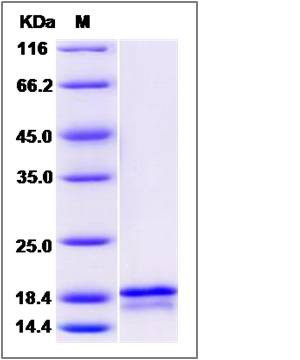Human FGF6 / FGF-6 Protein
HBGF-6,HST2
- 100ug (NPP1283) Please inquiry
| Catalog Number | P11528-HNAE |
|---|---|
| Organism Species | Human |
| Host | E. coli |
| Synonyms | HBGF-6,HST2 |
| Molecular Weight | The recombinant human FGF6 consists of 169 amino acids and predicts a molecular mass of 18.9 KDa. It migrates as an approximately 19 KDa band in SDS-PAGE under reducing conditions. |
| predicted N | Met |
| SDS-PAGE |  |
| Purity | > 95 % as determined by SDS-PAGE |
| Protein Construction | A DNA sequence encoding the mature form of human FGF6 (Gly41-Ile208) was expressed with a N-terminal Met. |
| Bio-activity | Measured in a cell proliferation assay using BALB/c 3T3 mouse fibroblasts. The ED50 for this effect is typically 0.1-0.6 ng/mL. |
| Research Area | Immunology |Inflammation / Inflammatory Mediator |Inflammatory Cytokines & Chemoki and Receptors |FGF Family |
| Formulation | Lyophilized from sterile PBS pH 7.4 1. Normally 5 % - 8 % trehalose and mannitol are added as protectants before lyophilization. Specific concentrations are included in the hardcopy of COA. |
| Background | FGF6, also known as FGF-6, belongs to the fibroblast growth factor (FGF) family. Members of this family possess broad mitogenic and cell survival activities, and are involved in a variety of biological processes, including embryonic development, cell growth, morphogenesis, tissue repair, tumor growth and invasion. FGF6 plays an important role in the regulation of cell proliferation, cell differentiation, angiogenesis and myogenesis. It is also required for normal muscle regeneration. FGF6 gene displayed oncogenic transforming activity when transfected into mammalian cells. |
| Reference |
